1
Section One: The Fundamentals
A) What do we know about sport? What are common assumptions we make about sport and society?
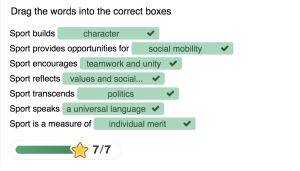
| Sport organizations require a plethora of factors to be successful. From the organization, to the accessibility, to the resources needed from both supplier and consumers of sports, it takes a great deal of factors to align for people to be able to participate in sports. This can and often does create barriers for those that cannot meet these criteria. As an elective choice, sports require elective money and time. This often cannot be afforded by everyone, as from a situation to situation basis, every single person is different. Many do not have the ability to drive long distances for sports, for example, or afford the equipment and gear to participate, having not elective money to spend on these things, or extra time due to more vital matters. There should not have to be a sacrifice of well-being when pursuing something as rewarding to general wellbeing as sports. Within this idea, I would support Rawls proclamation for a system of liberty for all. Liberty within sports should mean not having to worry about hinderances that come with it, at least those that are manageable, such as making sports to begin with, more financially accessible.
As well, the pressure of sports, one could argue, is a definite hindrance in social mobility. I can think of examples from my own childhood of seeing parents that put too much pressure of their kids, causing turmoil within their children in regards to sports competitions. Another example that comes to mind would be stories of parents drinking and driving their kids home after games, due to things like long distances of travel, unable to afford hotel fees, or drinking culture and poor accountability. Many systematic consequences still exist in the world of sports.
Response 1:
Hi! I really appreciated your discussion because it really got me thinking about pressures within sports. I specifically appreciated your point on skill-level and favouritism because it got me thinking about even those that don’t want to be there, but are competing due to pressures to perform. These pressures can come from those close to you, or from external pressures of representing one’s teams and commitments made. There can be a feeling of not letting down those depending on you, while leaving one’s own needs behind. These pressures definitely do not help promote a feeling of genuine unity.
Response 2:
I completely agree with your point. You cannot separate sports and politics. To add to your opener of real-world examples, Russia just this year did not compete in the Olympics, not an intentional statement, but nevertheless a large political statement was made. Sports exist everywhere, but especially on the world stage, politics will always be intricately linked. |
Exercise 3: Notebook prompt
What are some other metanarratives about sport that you are familiar with? Find an image or video clip or draw something yourself that captures this idea…
So what? Why does any of this matter? Does it matter? As something we grow up with – live with – play through – we don’t often interrogate the meanings of sport, and perhaps we don’t want to.
But being aware of these assumptions and metanarratives is especially important, I would argue, because of the centrality of sport to our everyday lives, the role that sport plays in shaping our childhood and worldviews and….. [finish that thought]
| An additional metanarrative of sport that I have no doubt we will explore further in the course would be overall ‘perceptions’ of athletes in sports. Under the wing of the metanarrative that is cultural identity and national pride, I would add perceptions as another because I believe that unfortunately politics and sports will always be in some shape or form interconnected. There has historically been prejudices and discrimination to certain groups of people in sports, and these also shape our perceptions of sport throughout our childhood and later worldviews.
|
B) What is social justice?
Exercise 4: Padlet Prompt
Think back to the last section and try to look at some of the ideas we discussed differently. How might sport and social justice actually co-exist?
Record any images, video clips, or gifs you added to the padlet and identify a point of intersection between sport and social justice (can be an issue or a barrier or a debate or something you would like to explore in more depth in this course) . Screenshot or paste in your response below.
| Commodification in Sports and Social Justice
Within major sports, especially those in higher platforms with international or global stages, there is great opportunity for reflection on social issues, as sports is a community event with huge engagement. Sports have historically “reflected and reinforced various hegemonies of oppression and inequality in our society such as racial, gender, sexual orientation, and social class prejudices” (Lee and Cunningham) and in response, “many athletes have used their positions of fame and popularity to ask their fans to get involved in social justice advocacy” (Lee and Cunnningham). This form of activism is using a platform to speak out on issues, to those with the power to change it, which in turn, holds these decision makers accountable. This can be a very powerful force. However, this force comes with setbacks. According to a study done by the Journal of Global Sport Management, “despite the noteworthy first three waves of resistance, the level of activism and resistance seemingly diminished in subsequent decades” (Cunningham), meaning present-day, as many athletes refrain from forms for activism due to “their desire to focus solely on athletic excellence or because of the potential financial repercussions of discussing controversial social issues” (Cunningham). Conversely so, within corporations, “stakeholders who enthusiastically benefit from this (somewhat contested) ‘social movement’” (Hayhurst) can also be a catalyst for social justice in sports becoming commodified. This is a huge problem as it goes against the principle purpose of using such platforms for people who are unable to stand up for themselves and the viewership it gains for the purpose of social awareness and thus engagement in these issues. It is a slippery slope if corporations who are often doing the harm in the first place, are controlling where and when any activism can take place.
Works Cited
Lee, Woojun, and George B. Cunningham. “Moving Toward Understanding Social Justice in Sport Organizations: A Study of Engagement in Social Justice Advocacy in Sport Organizations.” Journal of Sport and Social Issues, vol. 43, no. 3, 2019, pp. 245–63, https://doi.org/10.1177/0193723519832469.
Hayhurst, Lyndsay M. C., and Courtney Szto. “Corporatizating Activism Through Sport-Focused Social Justice? Investigating Nike’s Corporate Responsibility Initiatives in Sport for Development and Peace.” Journal of Sport and Social Issues, vol. 40, no. 6, 2016, pp. 522–44, https://doi.org/10.1177/0193723516655579.
Cunningham, George B., et al. “A Site to Resist and Persist: Diversity, Social Justice, and the Unique Nature of Sport.” Journal of Global Sport Management (Print), vol. 6, no. 1, 2021, pp. 30–48, https://doi.org/10.1080/24704067.2019.1578623.
Response 1:
Hi, Sommer, Thank you very much for your response because you show a fantastic example of sports and activism, but particularly an example from event-goers instead of the typical notable figures we often see speaking out. I loved seeing that from Canadians who are currently very upset with our neighbours and are using the opportunity of a very pivotal and well-seen game, that we as a nation, are unhappy. I love to see how the audience recognized the power of a collective that they themselves are.
Response 2:
Hi, Thank you very much for your response as it particularly got me thinking about how Nike in particular is a corporation that has made themselves, as a brand, an advocator for change. In your response, you reminded me of the good things that Nike has actually used their power for good, in Nike’s Made To Play initiative for example, and this is great to see because a huge part of using one’s brand for good, is actually fulfilling the image that they have created for themselves. Sport corporations that use social change as creative advertising must be held accountable in this position.
|
C) Social Justice Reading
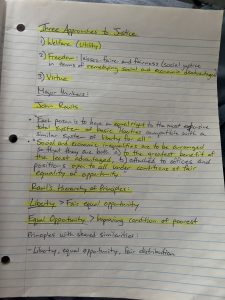
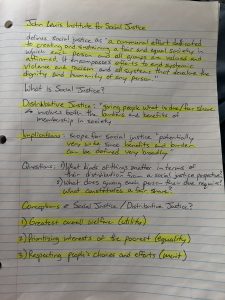
D) KINESIOLOGY AND SOCIAL JUSTICE
Exercise 5:

Exercise 6:
What are the implications of bodies-at-risk discourse and the refusal to understand the health gap from a social justice perspective, according to the authors of this article?
| The bodies at risk discourse falls under the idea of healthism which is the standard of health and fitness as dictated by a neoliberal thought stream of whiteness. In this standardizing, the bodies-at-risk discourse refers to anyone who does not fit these standards, which often ends up being minority groups. The implications of this is that it refrains from understanding the wider social justice perspective of health disparities such as environmental, social, or economic disadvantages of some people, as well as those with disabilities, or cultural disparities. Setting a standard without these perspectives in account creates a system where certain groups, minority and marginalized groups, are left behind, and as well referred to as a problem that needs to be fixed for not meeting the standard set. This is a neoliberal global imperative that has created health and fitness this way into a commodity, and shapes those that do not fit this imperative as irresponsible citizens, further alienating these groups, going so far as to predict and label these groups as ‘at-risk’. What is needed to reduce and eliminate this health gap is first recognizing these systematic roots, and culturally competent teachers that are willing to address the disparities.
|
Section Two: Sport Feminism
Exercise 7: Notebook Prompt
What is feminism? What does it mean to you? Choose one of the images below and explain how it captures your understanding of feminism (or find one that does speak to you and paste this into your pressbook with an explanation of why it matters to you.
| To me, feminism is knowing your worth as a woman. Feminism, at least for myself, exists in more of a vacuum state, in how my worth is not compared to anything external, such as my worth in comparison to those more advantaged to me. That is the type of feminism I often see, but for me it is about embracing what it means to be a woman, and especially embracing the gifts that being a woman brings. We have a special empathy, resilience and strength in us, amongst many other special qualities, and I think feminism is about accepting yourself and your strengths as a woman, and everything we can do, and believing in that enough. Despite the forces against us, that belief in oneself does not waver, and through that belief, the desire and drive to accomplish goals is not hindered, at least from someone else’s belief in us as any lesser. That is why I chose the photo of Frida Kahlo. She was an extraordinary painter not just in physical talent, but in what she chose to portray. She portrayed the art of her culture, and of womanhood, and that was unlike anything ever seen at the time, and she is a champion in owning herself, her womanhood, and her nationality, despite growing up in a time period where women were very much marginalized. This to me shows true feminism in the exact ways I believe it is, and that celebrating our expression and emotion within ourselves and being unwavering in showcasing that.
|
Exercise 8: Notes Prompt (optional)
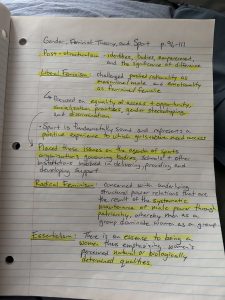



Exercise 9: Crossword Activity
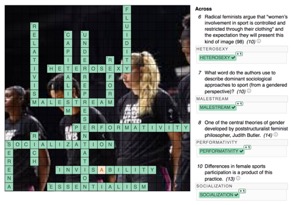
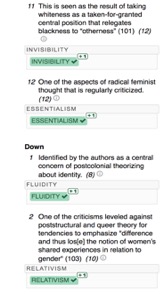
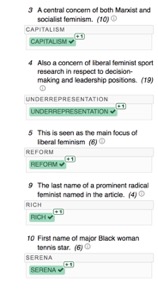
Exercise 10: Padlet Prompt

|

| A great deal of viewership in today’s digital world is determined by what the general public as a whole is watching. With the inclusion of social media particularly, or previously with the inclusion of media coverage of sports in general, it has often been key figures that propel viewership. These key figures would include those that have been dominating in the sport either of late or have been for a long time, and viewers focus on these players with special interest. In the spirit of sport, people wish to see how far these players can go and what they can achieve. In regards to women’s sports, and movements as a whole, it is often key players that bring attention to an organization. We have seen great women players in the arena of tennis, such as sisters Venus and Serena Williams, and they brought a great deal of viewership to the sport of tennis as a whole, not only just for recognition of women’s tennis specifically. As well, in the case of Simone Biles, her feats are extraordinary, and people tune in to her specific programs more than any other event of its kind during the Olympics. In that case, the fact that she is a woman brings greater attention to women’s sports and gymnastics, but viewers are tuning in simply because she is amazing at what she does and they wish to see her incredible feats, regardless of gender. In the case of women’s basketball, the case remains the same, with key players such as Caitlin Clark specifically, who is exceptionally good at the game, and so viewership spiked upon realizing this. In turn, it brought more viewership to women’s basketball as a whole, but I do believe that people who are unaccustomed to the sport, tend to tune in to watch their favourite players when starting out. We see this in hockey with people starting to watch because of players like Sidney Crosby or Connor McDavid, and once people are watching they grow attachments to the teams and sport as a whole. I do believe the landscape can change for women’s sports if there continues to be some very good players to root for, and bring in that initial viewership to grow the franchise.
|

